Michael's Long Box: The Crow/Razor - Kill the Pain
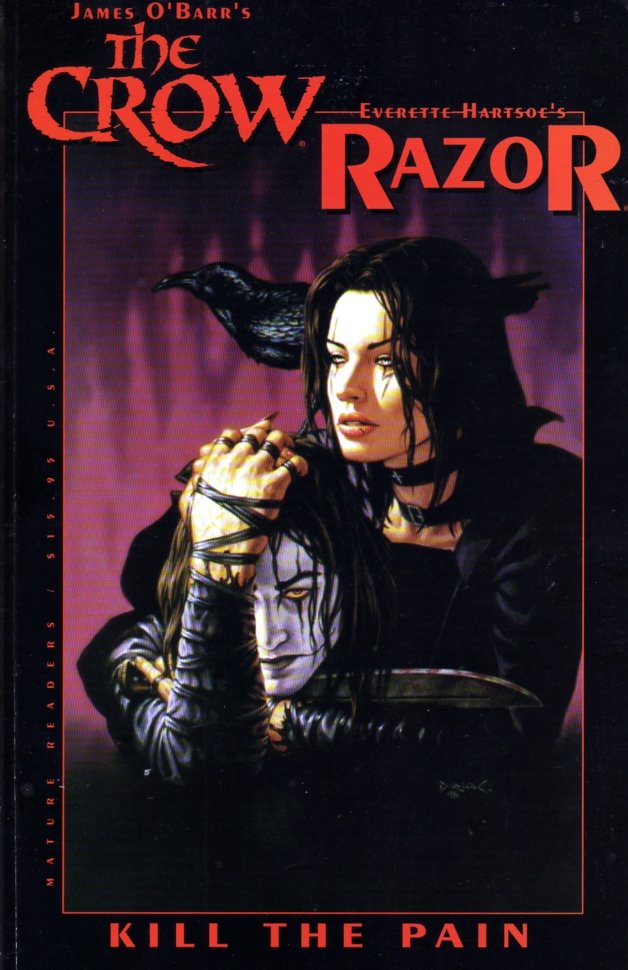
Note: All images in this article are scanned from my own sources unless otherwise noted.
Long-time readers know I'm a little obsessed when it comes to Razor. If you're not a long-time reader, then welcome to "Michael's Long Box", the column where I spill an obscene amount of electrons discussing comic books no one else has thought about for twenty years. Today we're looking at the most obvious choices for an indie book crossover event since Dark Horse published Aliens vs. Predator. It's a book @blewitt hordes in his storage unit, a book @bryan-imhoff would never admit to owning, and a book @cryplectibles would be happy to sell you in exchange for some thick, rich STEEM. This is The Crow/Razor: Kill the Pain. And it's...uh...well, it's definitely something that happened.
If you know anything about James O'Barr and Everette Hartsoe, then you already know why this project had been waiting to happen for almost ten years. Both O'Barr and Hartsoe used the comic medium as an outlet for their emotions. With O'Barr, The Crow was the result of the anger and helplessness he felt following the death of his girlfriend due to the carelessness of a drunk driver. With Hartsoe, Razor was born from the grief of losing his twelve-year old sister in a violent home invasion.
Both Razor and The Crow, at least in his incarnation as Eric in the comics, are similarly as shattered as their creators. A sadistic gang led by T-Bird (if you come at me in the comments about Top Dollar being in charge, I'll laugh at you for only having seen the movie) shoots Eric in the head, leaving him paralyzed and unable to help his fiancée Shelly as she is raped and murdered on the street in front of him. When the paramedics arrive, Shelly has already died but Eric is still among the living. He dies a short time later in the hospital, but is returned to a sort of un-life by a crow which guides him through acts of supernatural vengeance on T-Bird and his gang. Even after seeing them destroyed, Eric feels unfulfilled.
Razor, on the other hand, was once a young girl named Nicole, who witnesses her father executed by thugs employed by crime lord Roman Von Drake. Frank Mitchell's only crime was being a good, honest cop in a city where honesty and goodness were in short supply. The criminals take Nicole's sister, but don't realize Nicole watched the whole thing from her hiding place under the sink. Orphaned and alone, Nicole survives the Queen City foster care system and a stint in a mental hospital where she's subjected to intense physical, emotional, and sexual abuse before she manages to escape. Back on the streets, drug-addled and unable to cope with life, she adopts a second persona as "Razor". Much like Eric, Nicole is "reborn" in a sense as Razor, a vigilante killer who hones her physical skills to the limit and spends her nights roaming Queen City's alleys, dishing out lethal justice against those who prey on the weak. Also like Eric, no matter how much blood she spills, fulfillment is always out of reach.
These two were so made for each other you'd think one was the pie crust and the other the moist, juicy filling. It should be so immune to sucking that it repels your Roomba. If you hold this belief, given what you've just read, you're absolutely correct. You're also tragically wrong. It pains me to say it, but Kill the Pain is to black-and-white indie books what Deathmate is to full-color crossovers: a series with grand ambitions but no idea how to achieve them.
Comics are a unique storytelling medium. Every page, every frame, is an opportunity for both creator and consumer to press 'pause' and examine everything in depth before moving on. Artists can use panels, and even the pause created by turning the page itself, to expand the story beyond its simple text and artwork. It's an experience you can get in literally no other medium. In order for this to work, the words and the pictures must form a coherent, symbiotic relationship. Too many words over-crowd the picture and bog down the panels, no matter how gorgeously the pictures on the page are rendered. And even the best-rendered prose cannot compensate for artwork which fails to evoke both motion and emotion. Comics demand investment from their consumers and symbiosis from their creators the way film, radio, and novels all do not.
This stabs at the heart of why Kill the Pain fails. There's nothing inherently wrong with Hartsoe's script. Jerry Beck's pencils, Rick Davis's inks, and Albert Holaso's stand-alone full pages are all well-rendered. Despite this, they absolutely do not mesh. If this was just a normal Razor story, I would be more apt to let it be. The inclusion of O'Barr's iconic Fairy Goth-Father just pushes expectations up higher, and the story's failure is thus all the more painful. It's Hartsoe's script where I have to lay the bulk of the blame: this was just beyond his talents at the time.
Kill the Pain's story and presentation is an utter nightmare of jump-cuts and long-winded diatribes. This is what I've managed to glean from multiple readings of the TPB pictures at the top of this article:
- There's a demon, named "Pain" (how imaginative), causing trouble in Queen City.
- "Pain" feeds on the physical, mental, and emotional anguish of others.
- In Hartsoe and O'Barr's universes, no characters so gloriously manifest agony than Razor and Eric.
- Because of this, Pain decides it would be fun to torment both Eric and Razor to the breaking point.
- Razor and Eric, with the help of Eric's Crow familiar, resist Pain's attempt to break them by realizing the hurt in their hearts is what gives the demon his power.
- Forgiving themselves for their inability to defend their loved ones gives them the strength to turn the tables and destroy the demon.
And if the story was told as straight-forwardly as I described it, the book would have been all the better for it. Maybe if O'Barr had collaborated with Hartsoe on the story, this is what we would have gotten. Hartsoe seems to have used this book as an excuse to try something new though, and this time it just didn't work. There's a reason you don't call Zack Snyder to create a historical period drama, or Michael Bay to direct an art house romance: you wouldn't be playing to their strengths. Likewise, Hartsoe has a flair for telling simple tales of revenge and brutality. The higher-concept stuff he brings into this story goes over like a potent fart in a crowded elevator: even if you don't know who dealt it, your day's been altered for the worse as you ruminate on what sort of turd-herder behaves like that in public.
Much of Kill the Pain is told through text: the villain and the heroes spend an awful lot of time posturing and talking to one another. I know this is Hartsoe attempting to make "Pain" into some kind of uber-dangerous enemy, but the long-winded diatribes he throws at Eric and Razor make him sound like a gas bag. What's worse, we don't meet Pain until halfway into issue #2. For a story that runs four five six a London Night number of issues, a failure to introduce the antagonist right away means a loss of time for us to get to know him. That time has to be made up later, and that results in info dumps.
Beyond this, though, there's the problem with how Kill the Pain jumps around from point to point. We get a reprise of Eric's death scene, a Crow telling us we're going back to the beginning, and an encounter with someone mourning the loss of Eric and his inability to protect him. It's then the all-Razor show until the end of the issue, when Eric (this time as the Crow) shows up a second time. Issue 2 picks up Razor's story as she interrogates a low-life, the police find the results of Eric's work last issue, then we jump to a heist where one crime boss is stealing from another. Who are all these people? We don't know, and it doesn't matter, because Eric has fun wasting them to the last man, and finally we meet our antagonist, Pain.
Pain's thirsty for some tears, so he kills the gang member who came to report the hijacking and subsequent murder of the thugs, then gathers his boys to go sow some chaos. Then it's back to Razor and Eric again, two ships passing in the night of a graveyard, as they each visit the resting places of their departed loved ones. Eric then meets with the man from issue 1, his uncle, who has purchased a handgun and intends to take his own life. Eric talks him out of it. Back to Razor, then Pain's minions assault a political rally, and Hartsoe's fighting to keep the whole thing on the rails at this point.
Nicole is sometimes presented as being Razor, and sometimes as her own person with Razor being her own separate character. During an intense training session, one of them is holding the heavy bag while the other beats up on it...this despite them both being the same person. They even manage to share a kiss after one knocks the other down, which leaves both of them feeling terribly confused. This isn't the only time it happens, either--in the first issue, Nicole wakes from a nightmare to the feeling she's being watched, and asks, "Razor, is that you?" Imagine Bruce waking up in Wayne Manor, inquiring if the cowled figure standing over him was Batman. I get what Hartsoe's going for here: a Fight Club-esque series of Jack vs. Tyler moments, where we as the audience are supposed to question what's really going on, but this absolutely cannot work the way Hartsoe wanted it to. Readers unfamiliar with Razor, who picked the book up because of its link to O'Barr's Crow, will miss the significance of this completely and will be confused at best. Readers familiar with Razor's chronology, on the other hand, will be confused because we've never seen Razor and Nicole depicted as two separate personalities like this. It wasn't until my third time reading the scene that I realized what was supposed to be going on, and that Nicole wasn't kissing Kat. Rick Davis's inks do a fantastic job representing the scene and keeping Nicole and Razor out of focus:
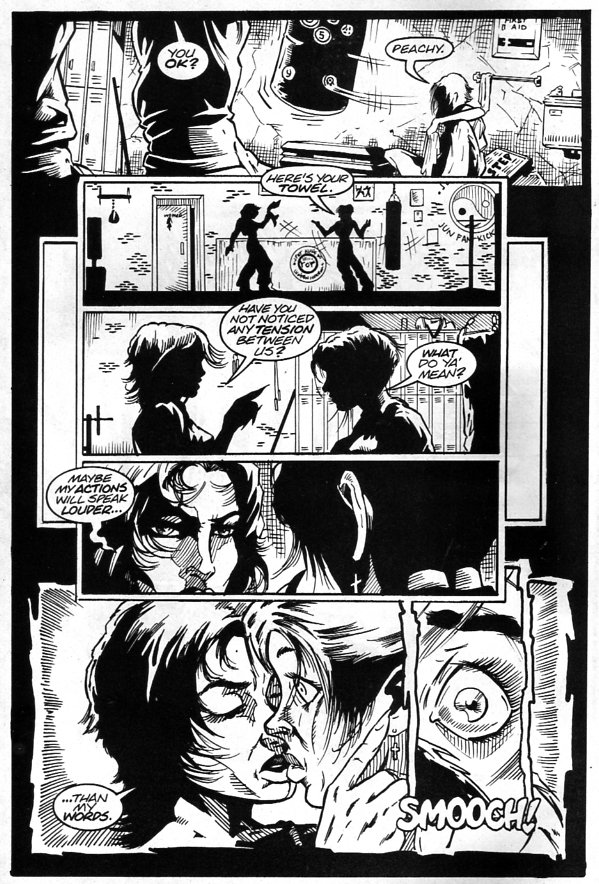
...but that doesn't change the fact the scene itself makes no sense, based on what we've seen before or since from Hartsoe's mind. Fight Club worked because we didn't know anything about either Tyler or "Jack" (as the narrator refers to himself in the third person) prior to the story's opening. In Razor though, we either know enough to confuse the hell out of us, or we don't know anything and the scene loses any sense of impact. I absolutely love what Hartsoe was driving at here: that Nicole still struggles to come to grips with her Razor persona, and the possibility that she enters a kind of fugue state when Razor takes over. It's just that without a history of this, the revelation falls flat and is never followed up on in subsequent titles or stories.
The climactic battle with Pain should be where this story earns its wings, with plenty of melee combat, flashing knives, and drawn blood. Instead, what we get from all three characters is lots of posturing and bravado. The conclusion to the story is essentially an essay by Hartsoe about why we need to release ourselves from our bondage to debts that were never ours to pay in the first place. They're fine words, but placed against the backdrop of a battle with a literal demon who feeds off the characters' suffering, the contrast is just jarring and somehow ineffective. It's disappointing, because again, I know Hartsoe can write this stuff well. Something, whether it was deadlines looming, spreading himself too thin across too many projects, or an attempt at taking on a story bigger than he was capable of lifting at the time, leaves a sour taste in the reader's mouth.
Finally, we have the London Night effect on issue count. The Crow/Razor started life as a four-issue mini-series that gradually bloated into the sort of excess that devastated the comic market in the 90's. We've already seen the TPB cover at the top of the article, so let's see what else was on offer, shall we?
First, we have the four main issues of the comic themselves:
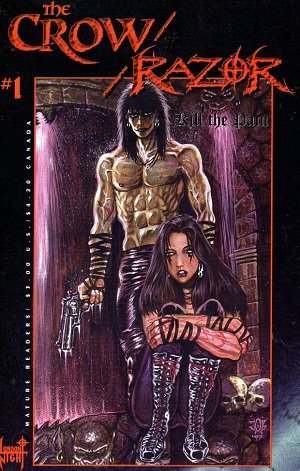
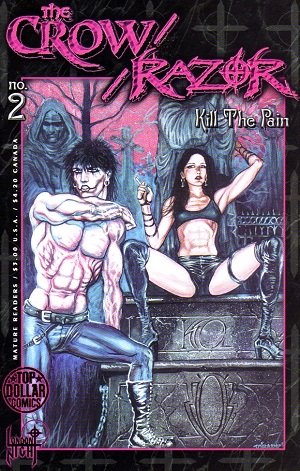
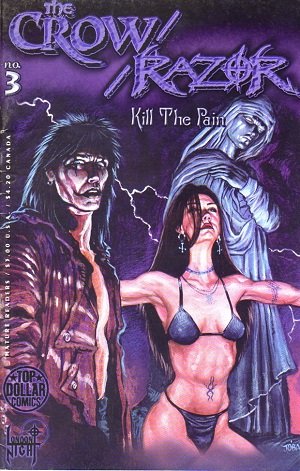
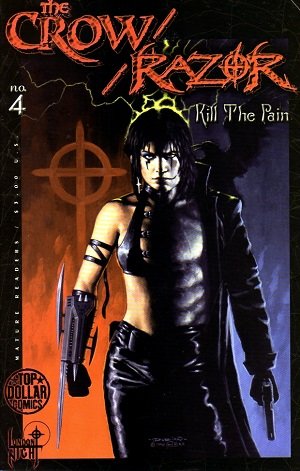
Each of those issues also featured a "Ministry Edition" variant. These are identical printings to the original issues, only with different cover artwork and higher cover price ($5.00 as opposed to $3.00). Interestingly, issues 1 and 2 of this variant feature thicker cardstock covers, while issues 3 and 4 are printed on the same glossy stock as the standard editions.
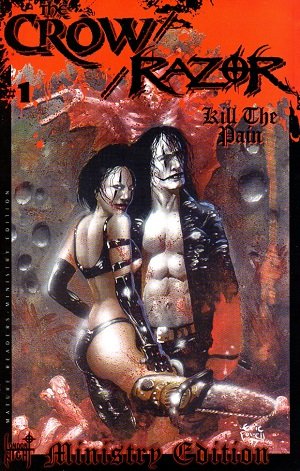
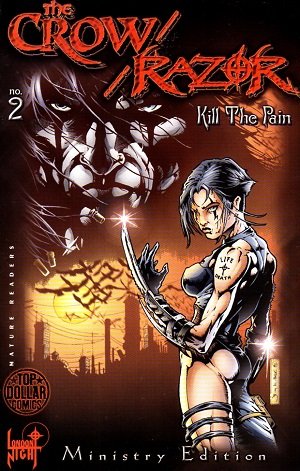
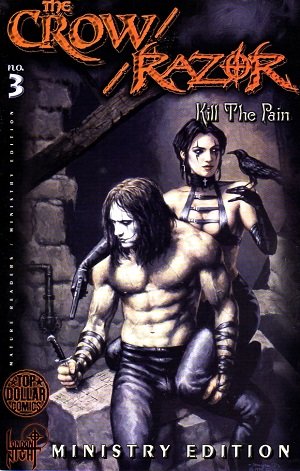
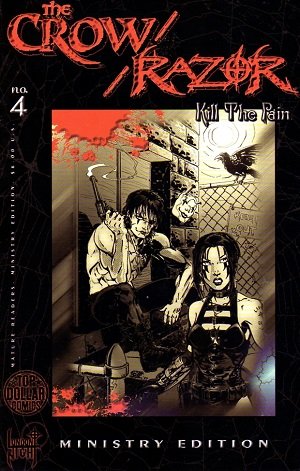
Then the fun begins.
Next up is Issue #0. Now, Zero-issues typically come before the events of the numbered series of which they are a part. This is why creators number them as "Zero". But those of you who've read my write-up on Razor's chronology know London Night understood numbers about as well as my cat understands how to shut the hell up in the early morning hours. It would be more accurate to call this "Issue #5", because it happens after the events shown in Issue #4, but the Hartsoe-verse is a scary, illogical place, so we get Issue #0 now instead of all the way back at the beginning, where it belongs:
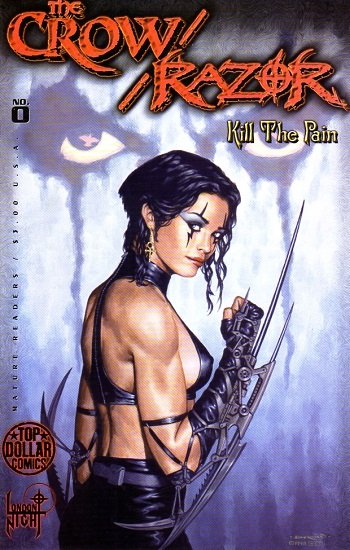
There's also a Ministry Edition of this book, which I don't have.
Now, Issue 0 ends with the words, "The End." This, to me, would indicate the story has concluded. But, ha ha, the joke is on all of us, because following the publication of Issue zero, we also got the "Finale", in both regular and Ministry Edition variants:
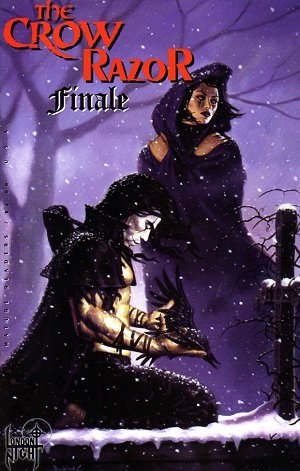
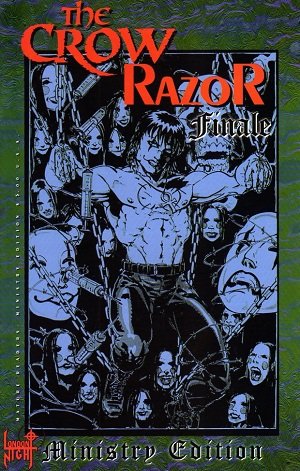
For those keeping track, we've now ended our Crow/Razor cross-over three separate goddamn times. We're done, right?
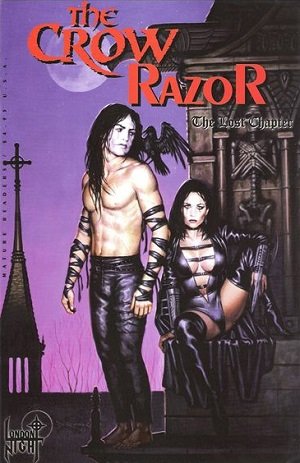
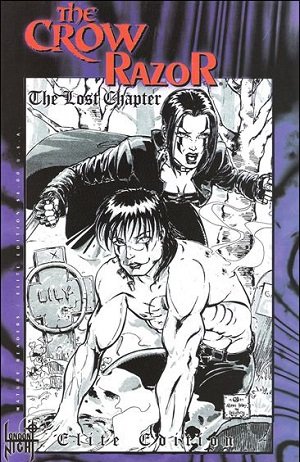
Oh, for fuck's sake...there's a Lost Chapter too? Of course there is. Of course there is. But this...surely this is how the story ends, is it not? IS IT NOT?! Well, yes, actually. "The Lost Chapter" is, absolutely, without question, the final entry in The Crow/Razor: Kill the Pain. But it's not the first.
Wait, what?!
Yeah, sorry. I neglected to mention the Tourbook.


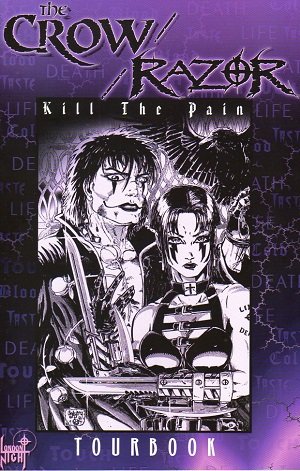
(There are actually four of these, but I'm missing the Black Border variant so I can't provide a cover image).
The Tourbook for Kill the Pain was a preview issue, showcasing the finished artwork for much of issue #1, and Everette Hartsoe's commentary about how and why the book came to be. It's nifty from a historical perspective, and the only difference between the versions I'm aware of is the cover artwork, as none of the interior pages change from one printing to another.
And, of course, what's a good crossover comic without an issue featuring nothing but interpretations of the theme by other artists? That's the impetus behind Nocturnal Masques, a thirty-two page art book featuring art by a slew of London Night and Top Dollar regulars along with some commentary bits by Hartsoe:
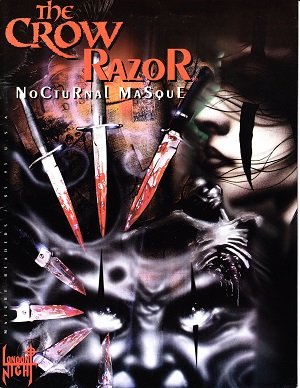
Image courtesy of Amazon
Oh, there was also this special gold foil and leather edition of issue #2, just in case you still had money left after acquiring all the other parts of this series:
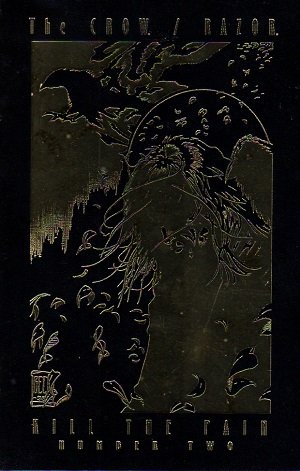
So, in order to fully collect every piece of this crossover, you need to invest in:
- Four standard issues ($3.00 each, or $12 total)
- Four Ministry Edition variant issues ($5.00 each, or $20 total)
- One issue 0 ($3.00)
- One issue 0 Ministry Edition variant ($5.00)
- One Finale ($3.00)
- One Ministry Edition Finale variant ($5.00)
- One Lost Chapter book ($4.95)
- One Ministry Edition Lost Chapter book variant ($6.00)
- Four Tourbooks ($5.95 each, or $23.80 total)
- One trade paperback ($15.95)
- One artwork collection ($5.95)
- One gold foil/leather edition of issue #2 ($10.00)
...for a grand total of $186.30 plus sales tax, assuming you paid cover price for each one of the twenty-one different pieces...and this is assuming there aren't other versions of these floating around out there with which I am unfamiliar. Research has turned up both Red and Silver foil leather variants of issue #1, for instance, but these were extremely limited run editions of 300 and 700 copies, respectively, so the chances of every fan being able to drop the extra $20 and $10 are remote indeed.
I've said it before, and I'll say it again: no matter what you think of Hartsoe's artistic abilities or writing talents, you cannot deny his obscene skills as a marketeer extraordinaire. Anyone who could convince his fans to drop nearly two hundred bucks on what should, by all rights, have been a four-issue limited series is a genius without peer. Likewise, if I just got you to read several thousand words about this disastrous crossover event, then the least you owe me is one of your precious upvotes. Consider it a down-payment on my next excursion into the depths of my depravity collection, and enjoy the rest of what's left of your weekend!
Congratulations, you have made it through this post and you are officially a goth. Don't forget your Marilyn Manson compact disc on the way out.
Amazing post! God damn that sucks this was a failure of a thing, I love how they at least knew the concept of these two together couldn't be broken by it being badly done, so tons of variant covers. I now want to draw these two together, and I suck for thinking the Ministry #0 cover looks kind of neat. Still not fully over knowing Eric Powell did one of those covers and what his looked like.
lol
Thanks, my good sir. Figured you might get a kick out of this.
You do not suck in the slightest for liking the Ministry #0 cover. For my money, standard edition #4 has the most iconic artwork: it's insane how well Dorian Cleavenger smashed the two characters together into one body. That image alone makes the imagination work overtime, IMO.
You should totally draw these two together. I'd love to see what you came up with! :D
Rough idea is this
OMG, it's beautiful! :D
Hi modernzorker,
Visit curiesteem.com or join the Curie Discord community to learn more.
🏆 Hi @modernzorker! You have received 0.03 SBD reward for this post from the following subscribers: @ilsaione
Subscribe and increase the reward for @modernzorker :) | For investors.
And I thought I was the master in the knowledge of useless shit department!!!! Lol.
Fantastic post brother. Tons of info here. I’ll dig out those Indy long boxes in the spring. We can go through em together on video so I can pluck out all the weird nonsense you’ll want.
When I left you, I was but the learner--now I am the master. ;)